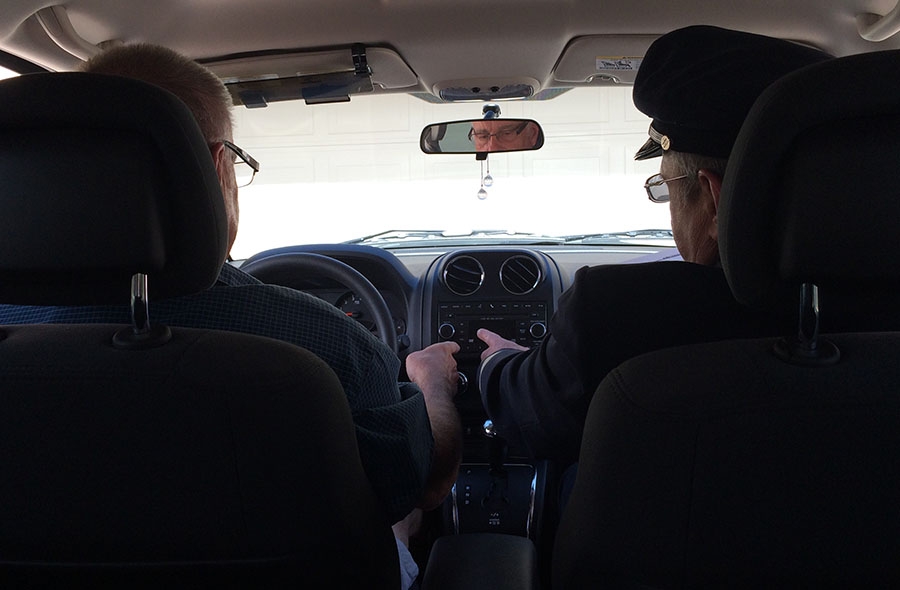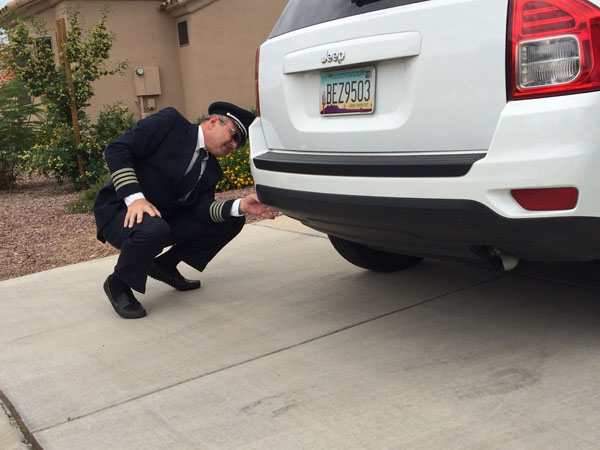
I have come to the realization from talking with the general flying public, that there is a lack of appreciation as to how robust safety standards are in the airline industry.
To illustrate, I will use the analogy of your car being the aircraft and any time you go anywhere, you will have an assistant….a “First Officer” commonly, but incorrectly, referred to as a “Co-Pilot”.
So, let’s get into your car and run across town to that favorite restaurant of yours.
For this scenario you will be the Captain, and I, your First Officer.
Before we leave, I will have needed an hour advance notice to get your car ready. Even though we just got back from Coffee Mania twenty minutes ago, we will run a complete pre-trip inspection. This is done every time we get back in the car to go somewhere. I will first check the weather, (which you will do as well) to determine if we may expect any delays; if so, we will then carry more fuel. I then begin to “pre-flight” the car. The first thing I will do is check the maintenance log. If ANY item wasn’t working properly from our previous drive, you would have written it up, and your car will not move until the maintenance crew has cleared the problem. Okay.. maintenance log looks good.
Now I walk around the car.. very slowly, inspecting every inch to determine if it is safe to drive. This will also entail my crawling under the car to check for any leaks or abnormalities. If there are any irregularities, I will note them in the maintenance log. If your tire tread is a little too worn for my liking, we will put a fresh tire on before we leave. Once I have found the car is roadworthy, I will get in and check every internal component of your car. Turn signals, lights, warning panel, radio, air conditioner, steering wheel, parking brake, horn, coffee pot…. you get the idea.
Then you get in. Before you even think about starting it up, you will ask me if the external checks, as well as the internal checks, are complete, which I will answer to the affirmative. Then we will discuss the drive… What route are we taking, is there any weather along our route, how high are the cloud tops, and did I get our clearance, to which I answer, “Yes”. Our clearance was my calling Traffic Control and letting them know we were going to “Chez Phillipe’s” for a bite. Traffic control advised us that our route was clear and they were expecting us to leave shortly.
Once you are satisfied that I have completed the vehicle inspection, you pull out a two page checklist and challenge every item I have already done, to which I answer “check” as I point to each item on the panel and you respond “cross check” to confirm I have done it, pointing at each item as well.
Are we almost ready to go? Yes, as soon as we get your two neighbors out here to walk beside your car, guiding you as you back very slowly out your driveway.
We’re now idling, aligned perfectly with the street; your neighbors give you the thumbs up and a quick salute. You salute back, and they return to their homes. Next is the one page after-start checklist to ensure that our engines are running smoothly, all our computers agree with each other, the battery is charging, we have A/C….and everyone is buckled into their seats. Oh yes… I forgot to mention that we have at least two engines in case one fails. In fact, we have at least one back-up for every component on the vehicle. As a quick side note, commercial aircraft must meet the minimum take-off-and-climb criteria based on an engine malfunction. In simple terms, a twin-engine jet is able to takeoff and climb on one engine.
You ask me to call for clearance to start moving. Note that there are three of us watching everything we do: you, me, and the Traffic Controller.
Now imagine every car on the road being tracked by controllers: a local controller gets you out of your subdivision where you are then handed off to a city controller. If you happen to be driving to another city, you would be handed off to an en route controller as well. They will watch us every step of the way to help with avoiding bumpy roads and keeping us clear of other traffic.
I call the local controller and he clears us to take Gypsy Road to Jungle Lane and to stop at the gate of our complex. I read back to the controller exactly what he asked us to do, and you read it all back to me. Now we can move. When we reach the gate we are handed off to the city controller and he clears us onto Main Street and to proceed on course. I read all that back, and again, you read all that back to me. As we accelerate up Main Street, you call for the cruise checklist. “Engine gauges all green” (we both point); “All systems green” (we both point); “Are you riding the brakes?” “Negative” you reply. “Cruise checks are complete.”

We can relax a bit now, as we are in our cruise segment traveling at 60 mph. Your job is to keep us aligned with your lane, and should you get within a few feet of the divider line I will bring it to your attention and you will reply with “correcting”. There are now four of us looking out for other traffic: you, me, the controller and our Traffic Avoidance System. The TAS is in every car and it’s a computer that monitors and “talks” to the other vehicles. If it believes we are getting too close to another vehicle it will turn us slightly one way and the other vehicle in the opposite direction. Side note again; in an aircraft, “too close” is considered as 1) converging, and 2) within 7 miles.
We are getting close to our destination, and the controller comes on and asks us to slow down to 40 mph for traffic ahead. I reply “slow to 40” and you repeat, “slowing to 40”. We don’t see the car we are slowing for and we won’t, because it is half a mile ahead of us. I ask the controller if we can keep our speed up and go around it. “No”, he replies, “there are three ahead of you going to Chez Phillipe’s.” And he adds, “You can expect a 5-minute delay”. We are still two miles away and are having to slow for three cars. The controller comes back on again with “You are cleared direct to Chez Phillipe’s, maintain 30 mph for spacing.” You now call for the arrival checklist… lights on, all systems functioning, seat belts. “Arrival checks complete”.
And here we are. You pull into a parking space as four attendants guide you in. You call for the shut-down checklist which we perform, and you hop out with “I’ll get us a table”. I stay to fill out the logbook and do another walk around the car to ensure it is in the same condition as when we left.
This is Captain Mark Kaufman signing off, and leaving you with one thought… If only drivers were required to operate as described, then cars would be the next safest mode of travel.. after flying.
The safest place in the world is on an airplane.

